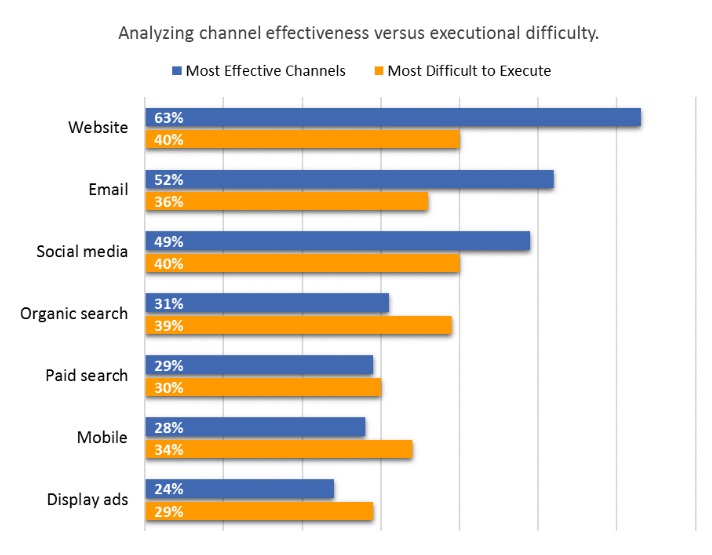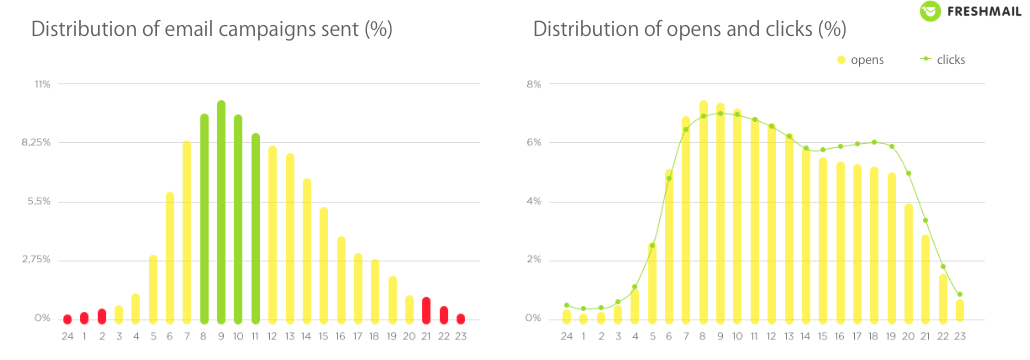According to a Radicati Group study from January 2017, there will be more than 3.7 billion email users worldwide by the end of the year. No other marketing channel comes close to the reach of email. Email also continuously outperforms other marketing channels, like social media or paid search. At the same time it remains the second most difficult marketing platform to execute.
 Image Source: kissmetric.com
Image Source: kissmetric.com
Email marketing is widely adopted but difficult to execute
Delivering the astounding 30:1 ROI that email is reported to deliver is not possible without obtaining, analyzing and using relevant data. Marketers must pay attention to who their subscribers are and how they are consuming email messages to get quality results with email.
At FreshMail, we analyzed how recipients are interacting with the campaigns that our users send. Despite the peak time for campaigns sent being a time window between 9:00 and 11:00am, the distribution of opens and clicks is rather continuous during the 24 hours. As presented on the graph below:
 Image source: FreshMail.com
Image source: FreshMail.com
You can clearly see that consumers are checking their email multiple times each day. But it doesn’t mean every single email campaign sent will be opened. The sender’s’ job is to prevent email marketing messages from being ignored. In order to push through the inbox noise, marketers must conduct personalised and automated email programs derived on the relevant data.
Just obtaining data doesn’t lead to a better email strategy. According to eMarketer, only 25% of businesses are putting their own data into use. Given that email is such a phenomenal revenue driver, this represents a significant lost opportunity.
Marketing Technology News: Gartner Survey Shows Inside Sales Organizations Risk Losing 24% of Employees This Year
Quality data use increases email marketing performance
As Deborah Womack said during Email Marketing Day in London, “In today’s complex mobile/digital world, seamless customer journeys build solid, mutually beneficial relationships between brand and customer.” Email is conductive in fostering relationships with subscribers during every stage of their buyers’ journeY, therefore it should be adopted to the individual needs of a single customer.
Mapping the email channel requires data points that tell if the campaign will appeal to given subscribers. There are different types of data which can be used to segment an email database: declarative, demographic, psychographic, etc, but the most reliable that give real insights are behavioural data. A variety of behavioral data can be obtained from ESPs, Google Analytics, CRMs, e-commerce platforms and other business solutions. If integrated into an email system, they enable finding true segments and personalising communication based on the needs of each segment.
Below are three examples of effective segmentation strategies based on behavioural data that can immediately lift email marketing results.
Segments determined by past purchases
This segmentation strategy is calculated with the use of RFM analysis. Each subscriber is assigned a score for recency, frequency, and monetary value, and then a final RFM score is calculated.
- Recency takes into account the date of a subscribers’ most recent purchase. The more recent, the better.
- Frequency assess the number of times the subscriber purchased. The more often the higher the score is.
- Monetary value is calculated based on the amount the individual subscriber spent on their purchases. The more money spent, the better.
Subscribers with an overall high RFM score represent the best customers who are potentially the best audience to be presented with a new offer. How to put this into practice?
For example, the first group consisted of subscribers with the highest score can receive regular newsletter communications and new offers first. The second best group made up of subscribers that are less active and loyal can receive a discount on their purchases. Finally, the group with the lowest RFM score could receive specific promotions to encourage further purchases or even a win-back campaign.
Marketing Technology News: Paysafe Announces YouTube Partnership
Segments based on a subscriber’s stage in the sales funnel
This segmentation strategy is based on a lead scoring technique. The marketers’ job is to generate leads, move them through the conversion path and turn them into satisfied customers. With the help of lead scoring, email marketing campaigns can be precisely adapted to the needs of all these groups of customers.
To begin with this type of segmentation all that is needed is behavioural data from Google Analytics inserted into the email system. Subscribers in the awareness stage are those who are visiting a website to obtain information and possibly discover that they have pain-points a company can help them solve. Subscribers in the consideration stage are website visitors who have shown an interest in the given solution. They are reading more advanced content guides, visiting “About us” pages or looking at other expertise content. Finally, subscribers who are in the decision stage visit pricing pages, case studies, and “Contact us” pages.
All these 3 segments can be set up with a Google Analytics goals function. Subscribers that have met predefined goals can be precisely targeted with the right message relevant to their stage in the sales funnel.
Segments based on multichannel touchpoints
This segmentation strategy is based upon the behavioural data obtained with various marketing platforms, like website analytics software, Google and social media campaign managers, etc. Data can all be brought together, allowing the gathering of more information across those touchpoints to form advanced email list segments.
This multichannel approach is the most important in delivering meaningful communications for each significant point in the customer journey via the right channel.
Marketing Technology News: Gartner Survey Shows Inside Sales Organizations Risk Losing 24% of Employees This Year
The importance of data management jurisdiction
Email is a global medium which introduces its own set of challenges, among others navigating the legal and regulatory frameworks that govern different jurisdictions. Checking local regulations for how to legally and properly collect and store data is a must.
To learn more on how to leverage data to build smart email marketing programs, download the ebook by FreshMail and InboxArmy here.












